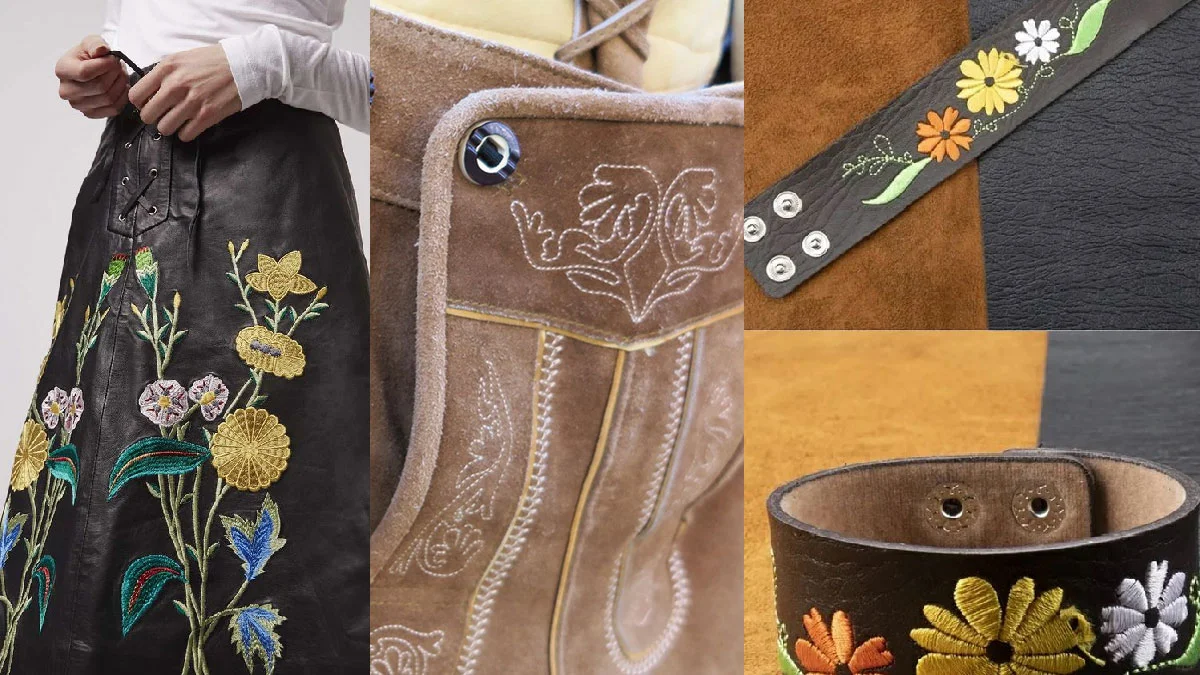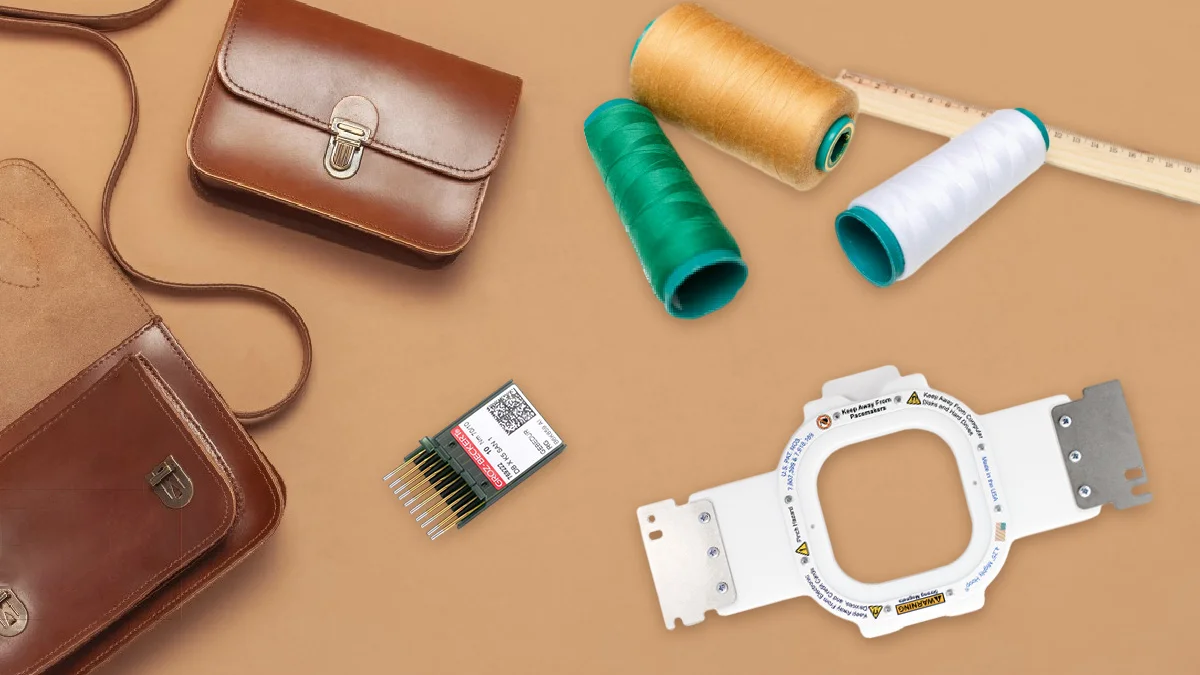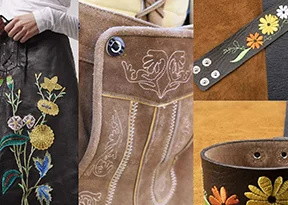
Logo Embroidery 101: Getting Started
2024-05-11
Pattern 950053
2024-07-25EMBROIDERY TIPS
Introduction to Leather Embroidery: Lesson One
POSTED ON MAY 11th,2024 BY BAi

The process of embroidering patterns or designs onto leather is known as leather embroidery. Whether done by hand or by machine, leather embroidery typically involves stitching patterns onto the surface of the leather. Nowadays, machine embroidery is more common on leather. All leather products can be decorated with embroidery, including jackets, baseball gloves, belts, handbags, and leather shoes. You can freely express your creativity on leather through embroidery.
Why leather embroidery?
Any leather product can benefit from the refinement and elegance brought by leather embroidery. Here's a brief overview of the advantages of leather embroidery.
Personalization:
Leather embroidery enables personalization. Customized leather embroidery can tailor designs to your preferences and needs, making each piece unique and distinctive. You can embroider your name on your wallet or your favorite pattern on your leather jacket, fulfilling all your imagination with leather embroidery.
Durability:
Leather embroidery stands out from other types of leather decorations for its durability. Unlike common leather decorations such as printing or painting, which may fade or peel off over time, leather embroidery is more robust and long-lasting. While it can withstand regular wear and tear, traditional decorations tend to deteriorate with time.
Brand Promotion:
For commercial brands or businesses, personalized leather embroidery is a powerful branding tool. You can embroider company logos or trademarks on leather products such as wallets, handbags, or cardholders to enhance brand recognition and elevate brand image.
Fashionable Art Display:
For fashion enthusiasts, leather embroidery is a unique and stylish technique. Delicate stitching can create eye-catching and distinctive designs, adding depth and sophistication to embroidered leather products.
How to Embroider on Leather
Before attempting to embroider on leather, make sure you have the appropriate tools and practice cutting to hone your skills, as it can be tricky. So, what materials and tools do you need for leather embroidery? I've listed the following materials and tools for you.
1.It's essential to distinguish between different types of leather when choosing leather for embroidery, including cowhide, lambskin, and suede. Each type of leather has unique thickness and elasticity characteristics. Avoid using overly thick leather as it may not yield good machine embroidery results. Leather that is too thin or too soft may not be suitable for machine embroidery. Opt for medium-weight leather whenever possible. Synthetic leather is an excellent alternative to genuine leather and can support denser, more intricate designs.
2.In addition to being careful in selecting leather, you must also choose your embroidery design with caution. Avoid designs that are overly complex or have excessively fine lines, as these may be challenging to replicate on leather. If your design includes text or intricate lines, ensure they are thick enough to be clearly visible on the leather. Too fine lines may distort during the embroidery process. Consider the color and texture of the leather and choose thread colors that complement them. The quality of color coordination directly affects the aesthetic appeal of the embroidery outcome.
3.For embroidering on leather, the most commonly used backing paper is adhesive stabilizer (also known as pressure-sensitive stabilizer) or double-sided adhesive paper.
Adhesive stabilizer is a type of paper with adhesive backing that allows you to secure the design onto the leather for embroidery. You can print the design onto the adhesive stabilizer, then cut it into the desired shape and adhere it onto the leather. The adhesive of the stabilizer helps maintain the stability of the design and is easy to remove after completing the embroidery.
Double-sided adhesive paper can also be used as a backing for embroidering on leather. It features adhesive on both sides, allowing you to secure the design onto the leather. You can print the design on paper and then adhere the double-sided adhesive paper to the back of the design. Next, align the double-sided adhesive paper with the leather and gently press it with your hands to ensure a firm bond. After completing the embroidery, you can easily remove the double-sided adhesive paper from the back.
These backing paper types all provide stability and convenience when embroidering on leather, ensuring the accuracy and stability of the design. Choose the backing paper that suits your embroidery project and personal preferences, and experiment and adjust as needed.
4.When embroidering on leather, using the correct needle is crucial. Leather embroidery needles have very sharp points that can easily and cleanly penetrate leather, vinyl, and similar fabrics. For lighter weight leather, use a regular size 11/75 leather needle; for thicker, heavier leather, use a larger size. One final point: be sure to purchase needles with a round shank designed for regular embroidery machines.
5.When it comes to selecting an embroidery hoop for leather embroidery, it's important to choose one that provides sufficient tension to keep the leather securely in place for stitching. Magnetic hoops or specialized thick hoops designed specifically for leather embroidery are often used for this purpose. These hoops offer enough tension to keep the leather flat and prevent wrinkling, which is essential for achieving high-quality embroidery on leather. Compared to regular embroidery hoops, leather embroidery requires stronger tension, making the choice of hoop crucial for improving work efficiency and embroidery quality.

How to better embroidery on leather
Adjusting the embroidery machine is crucial for leather embroidery to ensure the quality and effectiveness of the stitches. Here are some common adjustment steps:
1.Thread Tension Adjustment: Embroidery machines typically have a thread tension adjustment mechanism used to regulate thread tension. For leather embroidery, you may need to increase the thread tension to ensure it securely passes through the leather without loosening.
2.Needle Height Adjustment: Depending on the thickness of the leather, you may need to adjust the needle height of the embroidery machine. Adjust the needle to the appropriate height to ensure it can penetrate the leather smoothly without excessive penetration.
3、Embroidery Speed Adjustment: Embroidery machines typically have embroidery speed adjustment functionality. Depending on your skill level and the complexity of the embroidery pattern, adjust the embroidery speed appropriately to ensure you can maintain a good rhythm of embroidery.
4、Choice of Embroidery Backing: When embroidering on leather, you can choose to place backing material underneath the embroidery area. The backing provides stability and support, preventing the leather from deforming during embroidery. Depending on your needs, you can choose appropriate backing materials such as stabilizer fabric, wool felt, etc.
5、Use of Suitable Bobbin Thread: Choosing the right type and weight of bobbin thread suitable for leather is also important. It is generally recommended to use high-quality embroidery thread to ensure durability and aesthetics of the embroidery on leather.
6、Keep the embroidery area clean: When embroidering leather, ensure that the work area is clean and regularly remove debris and residues generated during the embroidery process to ensure the clarity and quality of the embroidery.
7、Embroidery Testing: Before embarking on the formal leather embroidery project, it is advisable to conduct embroidery testing. Select a piece of leather similar to the actual project for testing, adjust the parameters of the embroidery machine, and observe the embroidery results. Through embroidery testing, you can adjust and optimize the settings of the embroidery machine to achieve the best embroidery quality.
Please note that different embroidery machine models and brands may have different adjustment methods and functionalities. Therefore, it is recommended to refer to the user manual of the embroidery machine or consult relevant professionals to understand the specific adjustment steps and guidance for the particular embroidery machine.
In this article, we have learned the basic knowledge and skills of leather embroidery. We understand the special requirements of leather embroidery, including adjusting the embroidery machine settings, selecting appropriate needles and threads, and keeping the work area clean. Hopefully, this article serves as a good starting point for you and inspires you to further explore the world of leather embroidery. Remember to continue practicing and honing your skills. In the next lesson, we will delve deeper into more techniques and technologies of leather embroidery. Stay tuned!
-1.png)


Leave a Reply
You must be logged in to post a comment.